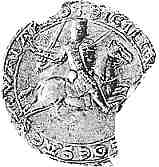
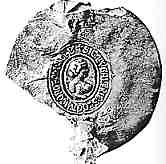
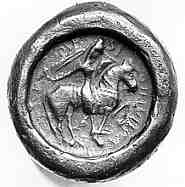

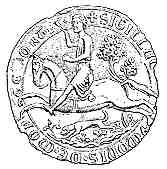
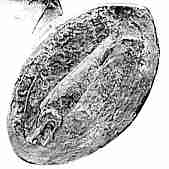



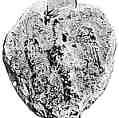
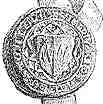

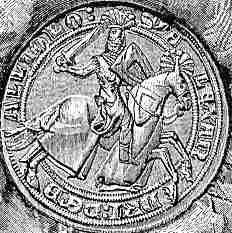
If you are looking at this page without frames, there is more information about medieval writing to be found by going to the home page (framed) or the site map (no frames).
| Aristocratic Seals | |||||||||
| The top dogs of the aristocracy, such as the barons, rapidly adopted the use of seals for their charters and important documents. This usage then trickled down through the various ranks of the aristocracy. The usual design in England in the century or so after the Norman Conquest was an imitation of the equestrian design on the royal great seal. Naturally the enthroned figure would not have been the done thing. The king was no doubt very jealous of that design. These aristocratic seals were therefore generally one sided, even though they hung from the bottom of the document on tags. Sometimes they bore a counterseal, or smaller, more personal seal, stamped into the back. | |||||||||
 |
 |
||||||||
| Seal and counterseal of Thomas de St Walery, from a document of 1192-1198 (Christ Church, Oxford). (From Salter, 1929) | |||||||||
| The above is a rather splendid example of the equestrian seal. Counterseals of the type shown here were often impressed with a gemstone carved in intaglio, that is carved in inverse so that the seal stands out in relief, set in a metal surround which bore the inscription. These carved gems were known from Roman antiquity, and some antique examples were utilised for this purpose, while in other cases fancy new medieval gems were carved. | |||||||||
 |
 |
||||||||
| 12th century equestrian seal of Ralph de Cuningburgh (British Library, add. charter 70691). By permission of the British Library. | 12th century seal of William de Braose (Magdalen College, Oxford). (From Salter, 1929) | ||||||||
| Some of these 12th century equestrian seals seem rather quaint and crude. Long, skinny knights brandishing huge swords seem to be trailing their spurs in the dirt as they ride short little horses with knobby knees. Among the many seals with rather similar designs, it is the written inscription around the seal which differentiates the owner. The equestrian seal remained the insignia of the upper echelons of the aristocracy throughout the 12th century. | |||||||||
 |
The designs diversified. The 13th century seal at left is of the equestrian type, but shows its owner out for a jolly day's hunting with his hound and his horn rather than wearing armour and riding a battle charger, which is rather strange when you consider his part in the belligerent affairs of his time. | ||||||||
| Seal of Simon de Montfort. | |||||||||
| Other conceptions of authenticating insignia appeared in which the actual design on the seal individualised it. The example on the right illustrates a concept which became popular in heraldry, the rebus, or pun on a name. The ferocious fish shown on the seal of Richard de Lucy is a pike, also known as a luce. |
 |
||||||||
| Seal of Richard de Lucy on a document of 1153-1154 (British Library, Campbell charters xiv, 24). (From Warner and Ellis, 1903) | |||||||||
| Some of the stranger creatures from the bestiary were recruited for seal designs. | |||||||||
 |
On the left, a late 12th century seal of Peter de Capella (Britsh Library, Harleian charter 83 A 51), on the right a mid 12th century seal of William Fossard (Britsh Library, add. charter 20561). (From Warner and Ellis, 1903) |
 |
|||||||
| The beastie on the left is a cockatrice, which is a tough and macho creature to have as an insignia as they could turn you to stone at a glance. For the one on the right, I rely on the description by Warner and Ellis, "a gryllus formed by the head and shoulders of a horned man, with sword and shield, set upon a bird's body, with right leg ending in an eagle's claw and left in a horse's hoof". I wouldn't want to meet one of those on a dark night. | |||||||||
| Some seals had animal designs which were drawn from the heraldic repertoire. | |||||||||
 |
|||||||||
| At left, 12th century seal of Robert de Bachepus (British Library, add charter 21172). (From Warner and Ellis 1903) At right, seal of Hugo de Plugeney of 1180-1190 (Magdalen College, Oxford). (From Salter, 1929) |
 |
||||||||
| The seal on the left displays a lion in the posture known to heraldry as passant, while that on the right, very faint and worn, appears to depict an eagle with outstretched wings. The development of greater complexity in heraldry combined with more intricate carving of seal matrices to produce more elaborate heraldic seals in the later middle ages. The authentication by visual image rather than simply by inscription became ratified by the rules of heraldry. | |||||||||
 |
At left, the seal of Richard de Straleigh of 1345, and at right, the seal of Sir William Cann of 1361. |  |
|||||||
| The fourteenth century seals above both have the shield of arms of the owner with an intricate, and yet architecturally inspired, carved background with the inscription surrounding it. | |||||||||
 |
For those personages of great note who felt they still deserved to flaunt the equestrian seal, the designs became more elaborate and intricate, including heraldic aspects. The seal at left shows the owner's shield of arms on both his shield and on his horse's trappings. The mounted figure wears the helm and crest that was later to become part of heraldic ornament. | ||||||||
| Seal of Alexander de Balliol of 1292. | |||||||||
|
|
|||||||||
|
|
|||||||||
|
If you are looking at this page without frames, there is more information about medieval writing to be found by going to the home page (framed) or the site map (no frames). |
|||||||||